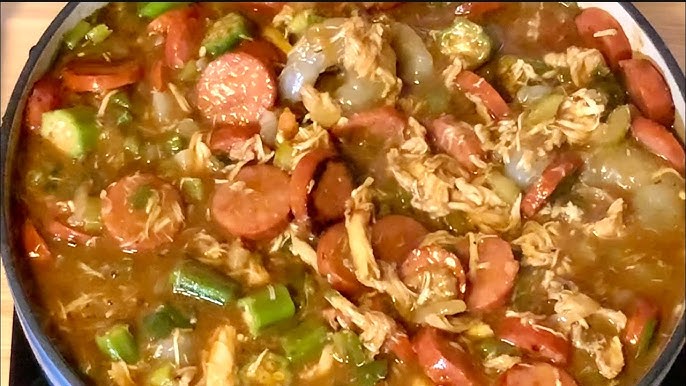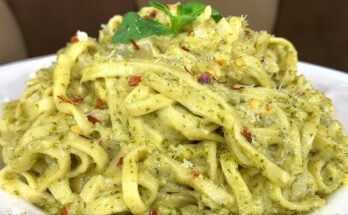Chicken and Sausage Gumbo Recipe: When you think of soul food or Southern comfort dishes, gumbo sits high on the list. This rich, hearty stew is a signature dish of Louisiana Creole cuisine, combining bold spices, soulful cooking, and a diverse array of ingredients into one savory bowl. What makes gumbo stand out isn’t just its taste—it’s the history it carries, a story told through flavor.
Gumbo isn’t just food—it’s a tradition. Whether you’re in New Orleans or in your own kitchen far from the bayou, preparing gumbo is a celebration. It brings people together, it’s the kind of dish made to feed a crowd, and it’s a comfort meal that warms you from the inside out.
The Fusion of Cultures in a Pot
Gumbo is Louisiana on a spoon. Influenced by West African, French, Spanish, and Native American culinary traditions, gumbo is a melting pot of cultures—literally. The use of roux from French cuisine, okra from African cooking, and filé powder from Choctaw cuisine gives gumbo a multicultural backbone.
Chicken and sausage gumbo is one of the most popular versions. The smokiness of the sausage paired with the savory, tender chicken makes it a favorite for home cooks and professional chefs alike. And the best part? It’s surprisingly simple to make if you follow a few key steps.
Ingredients You’ll Need
Core Proteins: Chicken and Sausage
The heart of this gumbo lies in its meaty base:
- 1 lb. boneless, skinless chicken thighs (cut into bite-sized pieces)
- 1 lb. smoked andouille sausage, sliced
Chicken thighs are preferred for their juicy, rich flavor, and sausage adds a smoky depth that elevates the dish.
The Holy Trinity: Onion, Celery, and Bell Pepper
No gumbo is complete without the “holy trinity” of Cajun and Creole cooking:
- 1 large onion, chopped
- 1 bell pepper, chopped (green or any color)
- 2 stalks of celery, chopped
These vegetables create the aromatic base that gives gumbo its signature flavor.
Essential Spices and Seasonings
Spices are the backbone of gumbo’s flavor:
- 3 cloves garlic, minced
- 1 tsp paprika
- 1 tsp dried thyme
- 1 tsp cayenne pepper (optional, adjust for heat)
- 1-2 bay leaves
- Salt and black pepper, to taste
Every spice adds a layer of depth. Don’t skip the garlic—it gives the gumbo a warm, savory boost.
Broth and Roux – The Heart of Gumbo
Gumbo’s defining characteristic is its roux—a cooked mixture of fat and flour that thickens the stew:
- ½ cup all-purpose flour
- ½ cup vegetable oil (or butter for a richer flavor)
For the liquid:
- 5 cups chicken broth
- 1 tbsp Worcestershire sauce
- Optional: 1 tsp hot sauce or filé powder (for added flavor and authenticity)
Step-by-Step Cooking Instructions
Step 1: Prepping the Proteins
Start by seasoning your chicken with a bit of salt, pepper, and paprika. In a large pot or Dutch oven, brown the sausage slices until they’re deeply caramelized—this step builds flavor. Remove them and set aside, then do the same with the chicken pieces. Browning both proteins separately ensures maximum taste.
Step 2: Making the Roux
This is the most critical step in making gumbo and where many people feel intimidated—but don’t worry, you’ve got this.
In the same pot, reduce the heat to medium and add your oil and flour. Stir constantly. You’re looking to cook the flour until it turns a deep brown color, almost like chocolate—this can take 20-30 minutes. Don’t rush. If it burns, start over.
Your roux is the flavor base. It should be nutty, rich, and dark—not burnt.
Step 3: Sautéing the Vegetables
Once your roux reaches the perfect shade of brown, add in the onion, celery, and bell pepper. Stir them in and cook for about 5-7 minutes until they soften. Then add garlic and cook for another minute.
Now you’ve got a fragrant, flavorful base that’s practically irresistible already.
Step 4: Simmering to Perfection
Return the sausage and chicken to the pot. Add in your spices, bay leaves, and Worcestershire sauce. Slowly pour in the chicken broth while stirring to avoid lumps.
Bring to a boil, then reduce the heat and let it simmer for at least 45 minutes, preferably longer. The flavors will continue to develop the longer it simmers.
If you like, add okra or filé powder here for extra thickness and authenticity.
Step 5: Serving Suggestions
Serve your gumbo over a bed of steamed white rice, garnished with chopped green onions or fresh parsley. Don’t forget some crusty French bread or cornbread on the side to soak up all that savory goodness.
Feeling fancy? Add a dash of hot sauce for a spicy kick!
Tips for Perfect Gumbo Every Time
Roux Tips for Beginners
Let’s be honest—making a roux is where most gumbo dreams either take off or crash and burn. But here’s the secret: patience is everything. You want a deep brown roux, almost the color of milk chocolate. To get there:
- Use equal parts flour and oil.
- Stir constantly—no breaks! If you walk away, it might burn.
- Use a heavy-bottomed pot or cast-iron skillet to avoid hot spots.
- Don’t panic if it takes 20-30 minutes. That’s normal for a deep roux.
If you’re new, start with a blonde roux and go darker each time you make gumbo. It’s like a rite of passage in Southern cooking!
Adjusting Heat and Seasoning
Gumbo is all about flavor balance—smoky, spicy, savory, and rich. Start small with seasonings, especially cayenne and hot sauce, then adjust as you go. Here are a few tips:
- Taste as it simmers—every 15 minutes or so.
- Add more salt only after it’s cooked down.
- Want more heat? Add cayenne or your favorite hot sauce at the end.
- A splash of lemon juice or vinegar can brighten up the flavors just before serving.
Remember: gumbo is personal. There’s no one way to season it—just the way you like it.
Common Mistakes to Avoid
Here are a few classic gumbo mistakes (and how to avoid them):
- Burning the roux: This ruins the whole pot. If it smells bitter, toss it and start over.
- Rushing the cook time: Gumbo isn’t a fast food—it needs time to simmer and deepen in flavor.
- Overcrowding with ingredients: Stick to your proteins and vegetables. Don’t throw in the kitchen sink.
- Skipping the rest time: Gumbo tastes better the next day. Let it sit and reheat it slowly.
- Using raw sausage: Always brown your sausage first. It adds that caramelized richness.
Avoiding these pitfalls will have your gumbo turning out rich, flavorful, and deeply satisfying.
FAQs about Chicken and Sausage Gumbo Recipe
Can I use other meats in gumbo?
Absolutely! Shrimp, crab, duck, or even rabbit can be used in gumbo. Just adjust the cook time and seasoning based on the meat.
What’s the difference between gumbo and jambalaya?
Gumbo is a stew served over rice, while jambalaya is a rice dish cooked with meats and seasonings. Gumbo uses a roux for thickening; jambalaya does not.
How do I store and reheat gumbo?
Store in an airtight container in the fridge for up to 4 days or freeze for up to 3 months. Reheat slowly on the stove over low heat, stirring occasionally.
Can I make gumbo gluten-free?
Yes! Use a gluten-free flour blend for your roux, or try making a roux with rice flour. Also, double-check your sausage and seasonings for hidden gluten.
What type of rice goes best with gumbo?
White long-grain rice is traditional, but jasmine or basmati work too. Some people love it with brown rice for a healthier twist.
Conclusion
The rich roux, the holy trinity of veggies, the slow-simmered meats—all come together in one unforgettable bowl. And once you master the technique, you can start experimenting—add shrimp, try different sausages, play with the spice levels. Make it your own.
Because at the end of the day, gumbo isn’t about perfection. It’s about bringing people together, sharing good food, and celebrating the flavors of the South.
So grab your pot, roll up your sleeves, and stir up a little Louisiana magic tonight.



